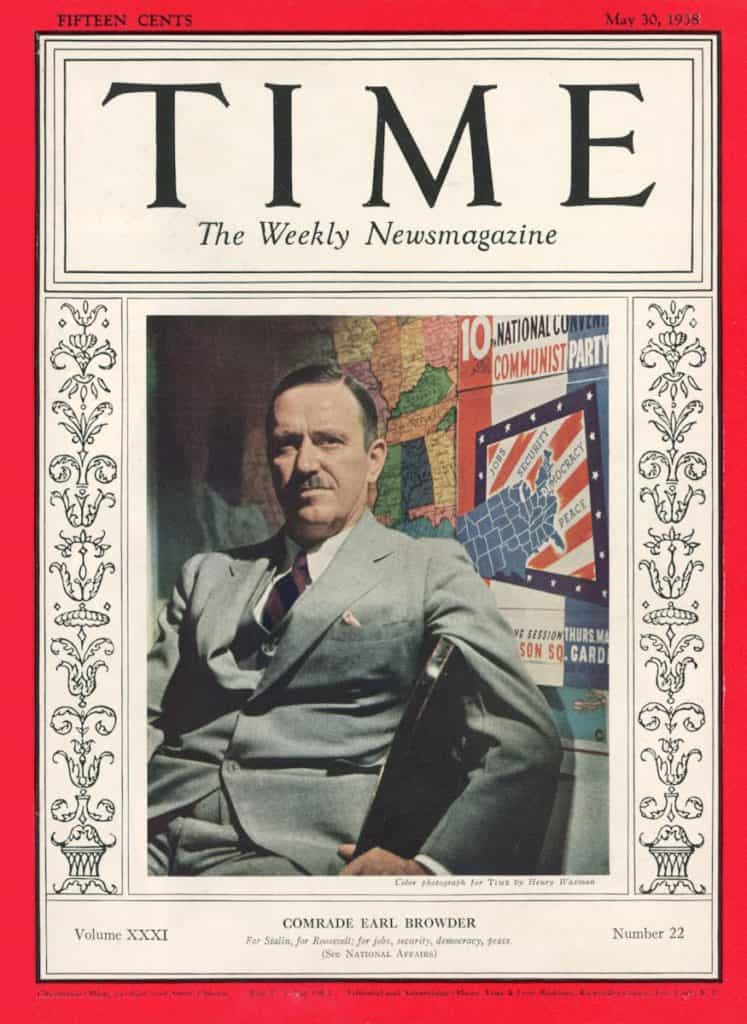
candidate, 1940, on the cover of Time magazine
By Mary Hoar, President Emerita, Yonkers Historical Society, recipient of the 2004 Key to History, Member of the Yonkers Landmarks Preservation Board, and President Untermyer Performing Arts Council
Monday, February 22nd
February 22, 1933: Women of the Yonkers Chapter of the Mooseheart Legion held a George Washington Pajama Party.
February 22, 1933: More than 4,000 people toured the new Genung’s Store in Yonkers during their 3 hour “Pre-opening” evening open house. Although no sales were to be made, the enthusiasm shown by the visitors, the sales staff was asked many questions about the merchandise. The storm also held a private reception from three to five pm that many of Yonkers better known citizens attended.
February 22, 1940: Chairman Louis Haas announced the local branch of the Communist Party endorsed the candidacy of Yonkers resident Earl Browder for President of the United States. He stated Browder should be the nominee because he represented workers, farmers and oppressed peoples of our country.
Tuesday, February 23rd
February 23, 1908: Alderman Adams advocated for mapping out of a general park system in Yonkers. He argued our city, “with a population of 75,000, is very deficient in the number of parks. They not only beautify the city but also serve as breathing places and healthful retreats for the poor.”
February 23, 1934: An electrical explosion in front of Proctor’s Theatre killed 3 people. Motorcycle Officer Patrick Whalen and passerby Michael Gruber leaped into the cellar to save a young girl they saw thrown into the pit of flames. The men managed to push 10-year old Gloria D’Addio to safety before they died. James Frazier, who had been working on a transformer in the basement, later passed away from severe burns.
February 23, 1944: Distinguishing scientist and inventor Dr. Leo Hendrik Baekeland passed away. He invented both Velox photographic paper and Bakelite, the first synthetic plastic, in his laboratory in Yonkers.
Wednesday, February 24th
February 24, 1927: G. R. Crecraft of the New York Telephone Company gave a fascinating presentation to the members of the Fellowcraft Club of Rising Star Lodge, F. and A. M. He spoke on the process to flash a picture simultaneously to all the important cities in the United States in on seven minutes! A beam of light was passed through a film positive and the varying intensities of light and shade were registered on a transmitter. The process, developed by the Bell Telephone System, was used mostly to transmit photographs of all recent events of national importance to the press.
February 24, 1930: Health Commissioner Clarence Buckmaster announced the Yonkers Academy of Medicine would purchase and donate books for a medical library in the Health Center to be built in City Hall Park.
Thursday, February 25th
February 25, 1906: Eleven boys were arraigned in City Court on charges of malicious mischief. Detectives for the NY Central Railroad accused them of planting small torpedoes under trains on the Hudson Line so they could steal rides. The boys, who confessed, said they put firecrackers on the tracks. When the engineer heard the noise of the explosions when the train hit them, he slowed the trains down and the boys jumped on. They said that some days they traveled as far as Poughkeepsie.
February 25, 1929: Ground for the new $925,000 Longfellow Junior High School on North Broadway was broken and excavation started immediately. Richard Edie, Jr., President of the Board of Education, dug the first shovelful of earth. This school later became Commerce High School.
Friday, February 26th
February 26, 1910: Vassar graduate Elsie LeGrand Cole told a Woman’s Day rally in Teutonia Hall that her part in the shirtwaist makers’ strike in New York City opened her eyes for the need for social and economic reforms. She continued that if women were allowed to elect lawmakers, many social and industrial hardships would be eliminated.
February 26, 1935: Governor Ruby Laffoon of Kentucky named former Morningside Avenue resident Herman P. Roos a Kentucky Colonel! Roos had been Secretary to the Prohibition Department Administrator until the repeal of the Eighteenth Amendment, had been assigned to the staff of the US Internal Revenue Department in Louisville. Roos graduated from School 9 and Yonkers High School.
February 26, 1945: A midnight curfew went into effect in Yonkers.
Saturday, February 27th
February 27, 1935: Alderman Sylvester Barker introduced a local law in the Common Council requiring a two-year residence for all Civil Service employees hereafter appointed by the city service.
February 27, 1940: City Manager Whitney submitted the 1940 budget to the Common Council. It gave salary increases to 11 people, cut 68 jobs, created 62 and maintained 412 employees at the same pay rate.
February 27, 1943: More than fifty Longfellow Junior High School students were inducted into the High School Victory Corp by Captain James Arbuckle, Commander of the 56th Regiment, of Company I, New York Guard. The student uniforms were navy slacks or skirts, white shirts and navy ties.
Sunday, February 28th
February 28, 1908: Commander Robert E. Peary, USN North Pole explorer, addressed the YMCA at the Library Hall on the topic, “Nearest the North Pole.” He spoke about the hardships, dangers and conditions existing in the Polar Regions.
February 28, 1931: City Hall announced city employees contributed more than $27,000 towards unemployment relief; Frank McCarthy, director of the Municipal Employment Bureau, reported Yonkers had 11,310 people out of work.
February 28, 1952: Demolition of the former Eschmann mansion on Warburton Avenue began to make way for an addition to School Twenty-five. Used for many years as a warehouse for Board of Ed supplies, the residence was built for the late f. W. R. Eschmann, onetime president of Arlington Chemical Company and his wife. Built at the beginning of the twentieth century, the Eschmanns lived there for 12 years, and then sold it. The stable and garage of the old estate housed the Engine 8 of the Yonkers Fire Department and the city owned the Eschmann dock at the estate’s riverfront.
For more information on the Yonkers Historical Society, Sherwood House and our upcoming events, please visit our website www.yonkershistoricalsociety.org, call 914-961-8940 or email yhsociety@aol.com.





